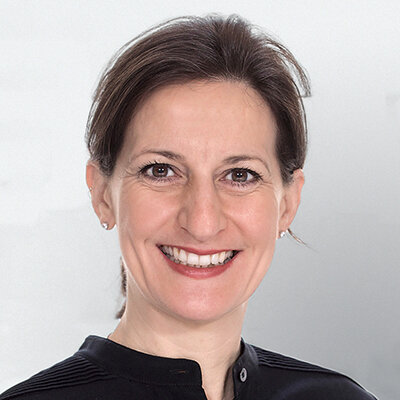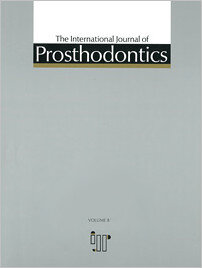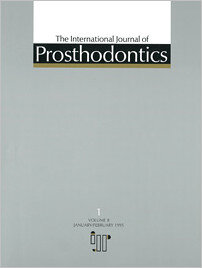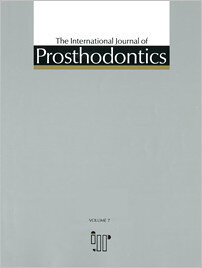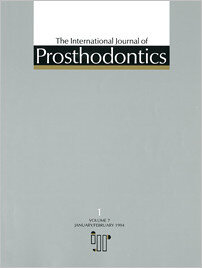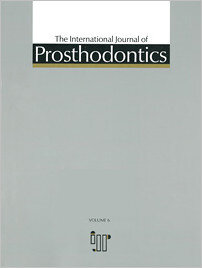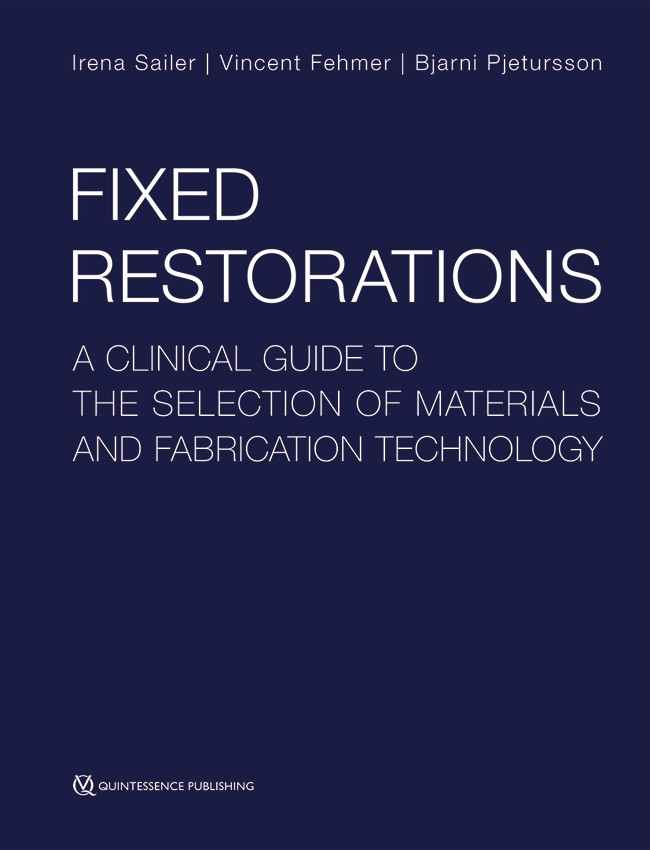Seiten: 301, Sprache: EnglischPreston, Jack D.Seiten: 303-310, Sprache: EnglischRinke / HulsIn this comparative in vitro study, the marginal accuracy and fracture strength of conventional and copy-milled In-Ceram crowns were examined. Anterior crowns with medians of 32.5 um for the conventional technique and 38 um for the copy-milled units had signifiantly smaller gaps than premolar crowns that had a median marginal gap of 45 um for both techniques. There was a significant difference in fracture strength only for anterior crowns. The study indicates that copy-milled In-Ceram crowns have clinically acceptable margins and fracture strength and reduce laboratory fabrication time.
Seiten: 311-319, Sprache: EnglischGiordano / Cima / PoberThe effects of surface finish on flexural strength of a feldspathic porcelain, aluminous porcelain, and a computer aided design-computer aided machining porcelain (Vitabloc MKI) were examined. A total of 105 bars of the feldspathic ceramic were made, randomly divided into seven groups, and sintered according to manufacturer's recommendations. The groups consisted of as-fired, self-glazed, overglazed, ground, polished, ground/annealed, and polished/annealed. A total of 45 bars of the aluminous ceramic and Vitabloc MKI were made and randomly divided into three groups: as-fired, ground, and polished. Overglazing, grinding, and polishing all significantly increased (P.05) the flexural strength (four-point-bend test) of the tested materials (15% to 30%).
Seiten: 320-323, Sprache: EnglischScotti / Catapano / D'EliaIn this investigation, 63 In-Ceram crowns were placed in 45 patients in both dental school and private practice settings. The restorations were observed for a period of 24 to 44 moths, with a mean of 37.6 months. Both anterior posterior teeth were treated and occlusal conditions were recorded. One crown fractured, yielding a 98.4% success rate. The single fracture was attributed to crown preparation geometry.
Seiten: 324-331, Sprache: EnglischMichelini / Belser / Scherrer / Rijk, DeThis in vitro study compared the tensile bond strength of gold and porcelain inlays to extracted molars in stanardized cavities. Three cements were used: zinc phosphate, glass-ionomer, and resin composite cement. The inlays were cemented using zinc phosphate or glass-ionomer cement, and the porcelain inlays were luted using resin composite or glass-ionomer cement. Surface treatments included, for gold inlays, either no treatment (zinc phosphate cement) or airborne particle abraded and tinplated (glass ionomer cement) or etched and silane-treated (resin composite cement). Statistical analysis was performed using the Weibull distribution. Results whowed no significant differences between gold inlays cemented using zinc phosphate or glass-ionomer cements. The bonded porcelain inlays (resin composite cement) showed tensile bond strengths two to three times higher than those obtained for cemented gold inlays.
Seiten: 332-336, Sprache: EnglischSchmitt / ChanceTraditional laboratory techniques are being supplemented by modern precision technologies to solve complex restorative problems. Electrical discharge machining combined with laser scanning and computer aided design-computer aided manufacturing can create very precise restorations without the lost wax method. A laser is used to create a three dimensional polyline data model that can then be converted into a stereolithography file format for output to a stereolithography apparatus or other rapid prototyping device. A stereolithography-generated model is used to create an alectric discharge machining electrode via copper electroforming. This electrode is used to machine dental restorations from an ingot of titanium, bypassing the conventional lost wax casting process. Retaining screw access holes are machined using conventional drilling procedures, but could be accomplished with electric discharge machining if desired. Other rapid prototyping technoloies are briefly discussed.
Seiten: 337-345, Sprache: EnglischLehner / Mannchen / ScharerA newly designed specimen allowed strength testing of simulated collarless metal ceramic crowns. The design provided precision replication of specimens having ceramic that were completely supported by metal or that were extended 1 and 2 mm beyond the metal support. Twelve specimens of each design were loaded to failure at angles of 90, 45, and 6 degrees. Specimens with unsupported extensions approximated the compressive strength of those with complete framework support (means of 291.6 MPa, 320.2 MPa, and 335.9 MPa, respectively, for 1 mm, 2 mm, and 0 mm of porcelain extension) when tested at 90 degrees. However, for corresponding porcelain lengths, mean resistance to fracture at an angle of 45 degrees was 7.3, 11, and 5.8 times smaller, and at an angle of 6 degrees, 45, 60, and 25 times smaller. The differences were highly significant (P.001). These results suggest that collarless metal ceramicc crowns having up to 2 mm of unsupported porcelain could resist the same axial pressure as those restorations with complete metal support.
Seiten: 346-350, Sprache: EnglischReisbick / BrantleyUsing polystyrene plastic patterns meeting the imensional requirements of ANSI/ADA specification no. 5, tension test specimens were recast multiple times from a popular Type 111 gold (46%) alloy. The alloy was melted by electrical heating in a graphite crucible and four conditions were compared: new alloy and alloy cast two, three, and four times (n=4). After casting, agehardened specimens were loaded at an elongation rate of .5 mm/min until failure, and the stress-strain plots were recorded. Values of yield strength tensile strength, and percentage elongation for the specimen groups were analyzed by one-way analysis of variance, followed by the Student-Newman-Keuls multiple range test. Significant decreases (P.01) in yield strength and percentage elongation occurred with recasting, although there were no significant differences (P>.05) in tensile strength. Scanning electronmicroscope examination revealed that the number of casting defects increased with remelting, and that their presence dominates the tensile fracture process. The variation in mechanical properties of the alloy with remelting was attributed to these casting defects.
Seiten: 351-369, Sprache: EnglischSuzuki / Kumagai / Watanabe / Uchida / NagaoNumerous metal allergies possibly resulting from intraoral metal restorations have been reported, although the mechanism of onset is not yet completely understood. Allergen elimination may be the most effective treatment, and location of allergen metal becomes essential. The x-ray flourescence spectroscope was used to detect the allergen metals in intraoral metal restorations and personal and household items of metal allergy patients. The apparatus was evaluated preceding its clinical application, and restorations and personal items for 381 pateints were analyzed to detect allergens. Successful diagnoses and allergen elimination treatment of three patients are reported.
Seiten: 370-376, Sprache: EnglischHada / Imai / Morimoto / Ishikawa / OoishiTo measure the movements of a maxillary denture in vivo it necessary to analyze the three-dimensional displacements induced. A measuring system consisting of four main units (a magnetic sensor, three optical fiber sensors, a sensor-setting jig, and a recorder) was developed. Using this system, the movements of a maxillary denture were continuously measured during tapping and during the mastification of a peanut.
Seiten: 377-391, Sprache: EnglischMcDevitt / Brady / Stack / HobdellThe authors conducted research to determine the structural relationships of the craniomandibular articulation that resulted when a mandibular reference position was established. A noninvasive clinical method was used to identify the record centric maxillomandibular relation in normal subjects and a suitable reference position in subjects with derangements of the craniomandibular articulation. The reference positions were checked for repeatability. Magnetic resonance imaging was used to determine the intra-articular relationships resulting from application of the clinical techniques. The normal subjects conformed well to the 1987 Glossary of Prosthodontic Terms definition, with the mandible close to first-tooth contact. In subjects with deranged articulations, the condyle was always in an abnormal relationship on the affected side in the reference position, and there were many intersubject variations.
Seiten: 392-397, Sprache: EnglischSato / Uyasa / Akagawa / OhkawaThis study used a two-dimensional finite element method to the preferred design for a cast circumferential clasp. Finite element models of the clasp arm with the constant flexibility were constructed, the stress was calculated, and the effects of taper and cross-sectional shape on stress were evaluated. The clasp arm with the taper of 0.8 showed less stress than those with other tapers, and the thinner and wider arms showed less stress than thosse with other cross-sectional dimensions. These results suggest that the use of the preformed clasp-pattern with a taper of 0.8 is preferable for reducing fatigue and/or permanent deformation of the clasp arm.



